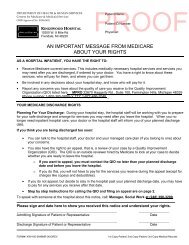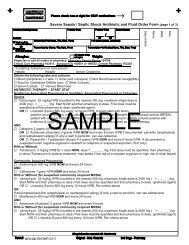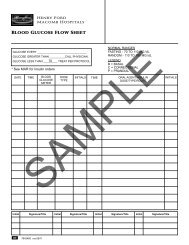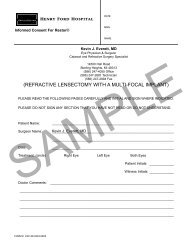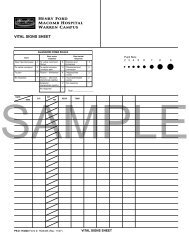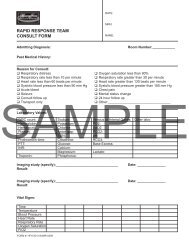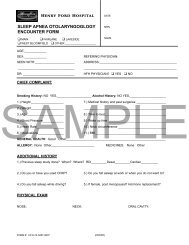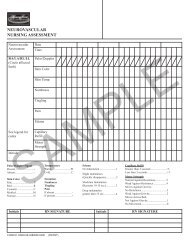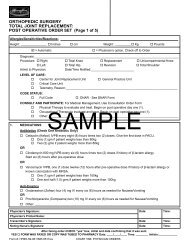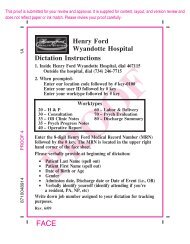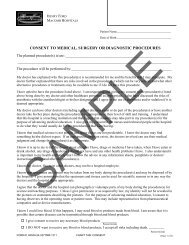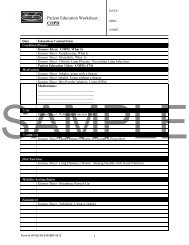HFBH-78-1230MR-0809
HFBH-78-1230MR-0809
HFBH-78-1230MR-0809
Create successful ePaper yourself
Turn your PDF publications into a flip-book with our unique Google optimized e-Paper software.
ALCOHOL WITHDRAWALASSESSMENT FLOW SHEET(Use with Clinical Institute Withdrawal Assessment-AlcoholRevised (CIWA-Ar) Score Sheet- on reverse)Please choose Symptom Triggered or Fixed Dose Therapy with Symptom Triggered as ordered onthe Alcohol Withdrawal Medication Order Form.Repeat CIWA-Ar score one hour after every dose, then every 4 hours until score is less than 8for 24 hours. If order changes, then use new flowsheet. If patient has CIWA-Ar score less than 8 for24 hours, then collaborate with physician for consideration of removing patient from protocol.Symptom Triggered Therapy Fixed Dose with Symptom Triggered TherapyIf CIWA-Ar score greater than or equal to 8, administer an additional dose ofmedication according to symptom triggered therapy dosage guidelines.Date:Time:SAMPLEA. Nausea/VomitingB. TremorsC. Paroxysmal SweatsD. AnxietyE. AgitationF. TactileDisturbancesG. AuditoryDisturbancesH. Visual DisturbancesI.Headache,Fullness in HeadJ. Orientation andClouding of SensoriumTotal ScoreCIWA-ArIf Respiratory Rate lessthan 8 or Pulse Ox lessthan 90%, withholdmedication. Notifyphysician.InitialsInitialsSignatureInitialsSignatureFORM#: <strong>HFBH</strong>-<strong>78</strong>-<strong>1230MR</strong>-<strong>0809</strong> (FRONT)
A. NAUSEA/VOMITING-Ask “Do you feelsick to your stomach? Have youvomited?” Observation:0 = No nausea & no vomiting1 = Mild nausea with no vomiting234 = Intermittent nausea with dry heaves567 = Constant nausea, frequent dryheaves & vomiting<strong>HFBH</strong>-<strong>78</strong>-<strong>1230MR</strong>-<strong>0809</strong> (BACK)F. TACTILE DISTRUBANCES-Ask “Have you anyitching, pins and needles sensations andburning, any numbness, or do you feelbugs crawling on or under your skin?”Observation:0 = None1 = Very mild itching, pins & needles, burning ornumbness2 = Mild itching, pins & needles, burning or numbness3 = Moderate itching, pins & needles, burning ornumbness4 = Moderately severe hallucinations5 = Severe hallucinations6 = Extremely severe hallucinations7 = Continuous hallucinationsB. TREMORS-Arms extended and fingers G. AUDITORY DISTURBANCES-Ask “Are you morespread apart. Observation: aware of sounds around you? Are they0 = No tremor harsh? Do they frighten you? Are you1 = Not visible, but can be felt hearing anything that is disturbing tofingertip to fingertip you? Are you hearing things you know are2 not there?” Observation:3 0 = Not present4 = Moderate with patient’s arms 1 = Very mild harshness or ability to frightenextended2 = Mild harshness or ability to frighten5 3 = Moderate harshness or ability to frighten6 4 = Moderately severe hallucinations7 = Severe, even with arms not extended 5 = Severe hallucinationsSAMPLE6 = Extremely severe hallucinations7= Continuous hallucinationsC. PAROXYSMAL SWEATS-Observation:H. VISUAL DISTURBANCES-Ask “Does the light0 = No sweat visibleappear to be too bright? Is it’s color1 = Barely perceptible sweating, palms moistdifferent? Does it hurt your eyes? Are2you seeing anything that is disturbing to3you? Are you seeing things you know are4 = Beads of sweat obvious on foreheadnot there?” Observation:50 = Not present61 = Very mild sensitivity7 = Drenching sweats2 = Mild sensitivity3 = Moderate sensitivity4 = Moderately severe hallucinations5 = Severe hallucinations6 = Extremely severe hallucinations7 = Continuous hallucinationsD. ANXIETY-Ask “Do you feel nervous?” I. HEADACHE, FULLNESS IN HEAD-Ask “Does yourObservation: head feel different? Does it feel like0 = No anxiety, at ease there is a band around your head?” Do not1 = Mildly anxious rate for dizziness or lightheadedness.2 Otherwise, rate severity:3 0 = Not present4 = Moderately anxious, or guarded, so 1 = Very mildanxiety is inferred2 = Mild5 3 = Moderate6 4 = Moderately severe7 = Equivalent to acute panic states as 5 = Severeseen in severe delirium or acute6 = Very severeschizophrenic reactions7 = Extremely severeE. AGITATION-Observation: J.ORIENTATION AND CLOUDING OF SENSORIUM- Ask“What day is this? Where are you? Who am I?”1 = Somewhat more than normal activity 0 = Oriented & can do serial additions2 1 = Cannot do serial additions or is uncertain3 about date4 = Moderately fidgety and restless 2 = Disoriented for date by no more than 25 calendar days6 3 = Disoriented for date by more than 27 = Paces back & forth during most of calendar daysthe interview, or constantly4 = Disoriented for place and/or personthrashes about



